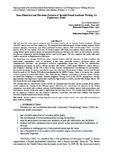Some rhetorical and discursive features of spanish dental academic writing: an exploratory study
Fecha
2008-05-05Palabras Clave
Grupo de Estudios Odontológicos, Discursivos y EducativosDental academic writing, Spanish, Research paper, Review articles, Case report, Discourse analysis, Genre analysis, Hedging
Artes y Humanidades
Metadatos
Mostrar el registro completo del ítemResumen
Some rhetorical and discursive features of spanish dental academic writing: an exploratory study.
(Morales, Oscar Alberto y Cassany, Daniel)
Resumen
We will describe some typical rhetorical and discursive features of the Spanish Dental Academic Writing (SDAW), which have not been studied yet. We analyzed three different genre of four leading Hispanic dental journals (Spanish, Venezuelan and Cuban) published between January 1989 and December 2005: 10 review articles (RA), 10 case reports (CR) and 10 research papers (RP) from each journal, which sum up 120 texts. Using Swales’ genre analysis model, we analyzed the rhetorical structures, the moves of the rhetorical sections, the physical components and the hedging devices used in each genre. We also compared our results with some studies carried out in English medical discourse. We found that even though SDAW has some common features with the discourse of other academic and professional communities, such as medicine, it has some particular features, rhetorical moves and communicative functions. The prototypical rhetorical organizations found were: In the RA, introductiondevelopment-conclusion; its moves coincide partially with Swales’ CARS model, Mulrow’s criteria, Myers’s and Noguchi’s findings. In the CR, a three-section structure predominated: introduction-case presentationdiscussion/conclusion. Its moves coincided in some way with those Taavitsainen & Pahta, Jenicek and Uribarri found in medical CR. Finally, RP followed predominantly the IMRDC format. Some of its moves were similar to those reported for medical RP (Swales, Day, Huth, Nwogu, Williams, and Hopkins & Dudley-Evans). Finally, we found that hedging is a common semantic-pragmatic strategy used in the SDAW, among those shields; approximators and impersonal constructions reported a high frequency, which coincide with Salager-Meyer. We also found deictics and compound hedges. We conclude that the characteristics of the SDAW, its communicative functions and the position of the authors could condition the writing of the different genres. Moreover, the expectations of members of the Dental community associated with academic writing could determine the way authors present their propositions, and their stances. Results could have didactic implications for teaching SDAW. We consider that it should be based on the empirical evidence: the way dentists (clinicians, researchers and professors) produce and interpret discourse in professional and academic settings.
Paper presented at: the 3rd International Santa Barbara Conference on Writing Research "Writing Research Across Borders", University of California, Santa
Barbara, EE.UU. February 22-24, 2008.
Colecciones
Información Adicional
| Correo Electrónico | oscarula@ula.ve, moralito_ve@yahoo.com daniel.casany@upf.edu |
| Editor | SABER ULA |






